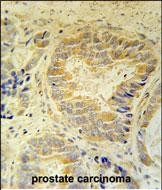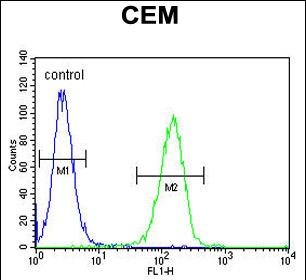FAM105B Antibody (Center)
Affinity Purified Rabbit Polyclonal Antibody (Pab)
- SPECIFICATION
- CITATIONS
- PROTOCOLS
- BACKGROUND

Application
| WB, IHC-P, FC, E |
|---|---|
| Primary Accession | Q96BN8 |
| Other Accession | Q3UCV8, NP_612357.4 |
| Reactivity | Human, Mouse |
| Host | Rabbit |
| Clonality | Polyclonal |
| Isotype | Rabbit IgG |
| Calculated MW | 40263 Da |
| Antigen Region | 99-128 aa |
| Gene ID | 90268 |
|---|---|
| Other Names | Ubiquitin thioesterase otulin, Deubiquitinating enzyme otulin, OTU domain-containing deubiquitinase with linear linkage specificity, Ubiquitin thioesterase Gumby, OTULIN, FAM105B |
| Target/Specificity | This FAM105B antibody is generated from rabbits immunized with a KLH conjugated synthetic peptide between 99-128 amino acids from the Central region of human FAM105B. |
| Dilution | WB~~1:1000 IHC-P~~1:50~100 FC~~1:10~50 E~~Use at an assay dependent concentration. |
| Format | Purified polyclonal antibody supplied in PBS with 0.09% (W/V) sodium azide. This antibody is purified through a protein A column, followed by peptide affinity purification. |
| Storage | Maintain refrigerated at 2-8°C for up to 2 weeks. For long term storage store at -20°C in small aliquots to prevent freeze-thaw cycles. |
| Precautions | FAM105B Antibody (Center) is for research use only and not for use in diagnostic or therapeutic procedures. |
| Name | OTULIN {ECO:0000303|PubMed:23806334, ECO:0000312|HGNC:HGNC:25118} |
|---|---|
| Function | Deubiquitinase that specifically removes linear ('Met-1'- linked) polyubiquitin chains to substrates and acts as a regulator of angiogenesis and innate immune response (PubMed:23708998, PubMed:23746843, PubMed:23806334, PubMed:23827681, PubMed:24726323, PubMed:24726327, PubMed:26997266, PubMed:27523608, PubMed:27559085, PubMed:28919039, PubMed:30804083, PubMed:35170849, PubMed:35587511, PubMed:38630025, PubMed:38652464). Required during angiogenesis, craniofacial and neuronal development by regulating the canonical Wnt signaling together with the LUBAC complex (PubMed:23708998). Acts as a negative regulator of NF-kappa-B by regulating the activity of the LUBAC complex (PubMed:23746843, PubMed:23806334). OTULIN function is mainly restricted to homeostasis of the LUBAC complex: acts by removing 'Met-1'-linked autoubiquitination of the LUBAC complex, thereby preventing inactivation of the LUBAC complex (PubMed:26670046). Acts as a key negative regulator of inflammation by restricting spontaneous inflammation and maintaining immune homeostasis (PubMed:27523608). In myeloid cell, required to prevent unwarranted secretion of cytokines leading to inflammation and autoimmunity by restricting linear polyubiquitin formation (PubMed:27523608). Plays a role in innate immune response by restricting linear polyubiquitin formation on LUBAC complex in response to NOD2 stimulation, probably to limit NOD2- dependent pro-inflammatory signaling (PubMed:23806334). |
| Cellular Location | Cytoplasm. |

Thousands of laboratories across the world have published research that depended on the performance of antibodies from Abcepta to advance their research. Check out links to articles that cite our products in major peer-reviewed journals, organized by research category.
info@abcepta.com, and receive a free "I Love Antibodies" mug.
Provided below are standard protocols that you may find useful for product applications.
References
Gerhard, D.S., et al. Genome Res. 14 (10B), 2121-2127 (2004) :
If you have used an Abcepta product and would like to share how it has performed, please click on the "Submit Review" button and provide the requested information. Our staff will examine and post your review and contact you if needed.
If you have any additional inquiries please email technical services at tech@abcepta.com.













 Foundational characteristics of cancer include proliferation, angiogenesis, migration, evasion of apoptosis, and cellular immortality. Find key markers for these cellular processes and antibodies to detect them.
Foundational characteristics of cancer include proliferation, angiogenesis, migration, evasion of apoptosis, and cellular immortality. Find key markers for these cellular processes and antibodies to detect them. The SUMOplot™ Analysis Program predicts and scores sumoylation sites in your protein. SUMOylation is a post-translational modification involved in various cellular processes, such as nuclear-cytosolic transport, transcriptional regulation, apoptosis, protein stability, response to stress, and progression through the cell cycle.
The SUMOplot™ Analysis Program predicts and scores sumoylation sites in your protein. SUMOylation is a post-translational modification involved in various cellular processes, such as nuclear-cytosolic transport, transcriptional regulation, apoptosis, protein stability, response to stress, and progression through the cell cycle. The Autophagy Receptor Motif Plotter predicts and scores autophagy receptor binding sites in your protein. Identifying proteins connected to this pathway is critical to understanding the role of autophagy in physiological as well as pathological processes such as development, differentiation, neurodegenerative diseases, stress, infection, and cancer.
The Autophagy Receptor Motif Plotter predicts and scores autophagy receptor binding sites in your protein. Identifying proteins connected to this pathway is critical to understanding the role of autophagy in physiological as well as pathological processes such as development, differentiation, neurodegenerative diseases, stress, infection, and cancer.




